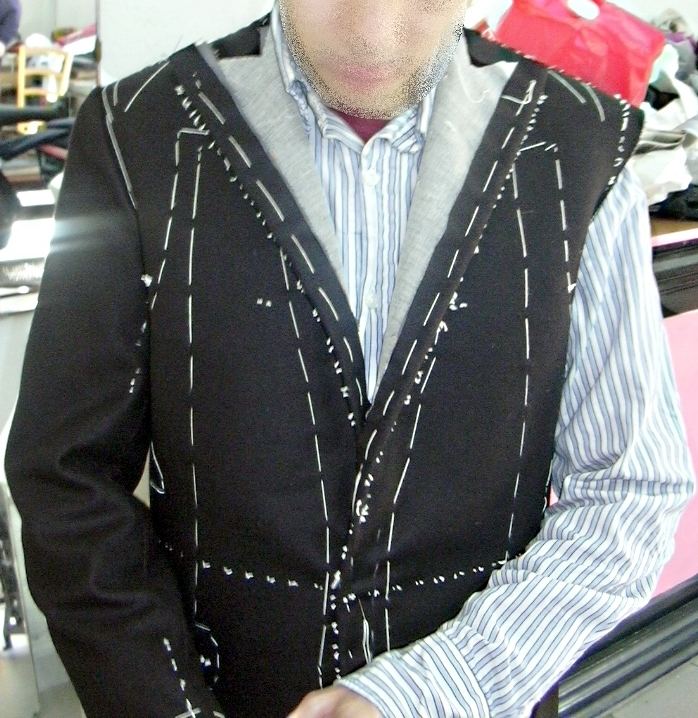 | ||
Bespoke tailoring /biˈspoʊk/ is clothing made to an individual buyer's specifications by a tailor. Cad & the Dandy, a modern Savile Row tailor, describes true bespoke tailoring as requiring a full floating canvas, basted fitting and detailed hand finishing, which distinguishes bespoke from the much more common made-to-measure. David Reeves, NYC based English Bespoke tailor and founder of REEVES sees made to measure as a compromised mass retail product at odds with his luxury bespoke ethos.
Contents
Meaning of the term
The word "bespoke" itself is derived from the verb "bespeak", to speak for something, in the specialised meaning "to give order for it to be made". The term bespoke in fashion is reserved for individually patterned and crafted men's clothing, analogous to women's haute couture, in contrast with mass-manufactured ready-to-wear (also called off-the-peg or off-the-rack). The term originated from Savile Row, a street in London considered the "Golden Mile of tailoring".
Bespoke clothing is traditionally cut from a pattern drafted from scratch for the customer, and so differs from ready-to-wear, which is factory made in finished condition and standardised sizes, and from made to measure, which is produced to order from an adjusted block pattern. The opposition of terms did not initially imply that a bespoke garment was necessarily well built, but since the development of ready-to-wear in the beginning of the twentieth century, bespoke clothing is now more expensive and is generally accompanied by a high quality of construction.
While the distinction conferred by haute couture is protected by law in France, the British Advertising Standards Authority has ruled it is a fair practice to use the term "bespoke" for products that do not fully incorporate traditional construction methods. The Savile Row Bespoke Association, a trade group of traditional tailors, disagrees.
Bespoke versus made-to-measure
Between the extremes of bespoke and ready-to-wear, there has existed since the end of the 19th century a "grey area of garments for which the customer was measured, but that were then made up to the closest standard size, often, but by no means always, in a factory." The distinction made here is between bespoke, created without use of a pre-existing pattern, and made to measure, which alters a standard-sized pattern to fit the customer. Technological change makes this distinction more subtle, since fittings are increasingly required for made-to-measure. A bespoke service may require an individually-cut pattern, which is then kept should further suits be required; made-to-measure measurements are often stored on a computer. Even hand-work, often cited as a benchmark of bespoke, is now increasingly found in made-to-measure garments, while machine-making plays some part in the creation of most bespoke suits. With a bespoke suit, a pattern is made from scratch based on the client's measurements, often from 20+ measurements. This ensures a precise fit, particularly in the shoulders as well as the posture areas. This custom fit is handy for clients with short or long necks, high or low shoulders, excess girth, high hips, large or flat seats, and more. Made-to-measure cannot adjust for these shapes and slopes.
Advertising Standards Authority ruling
In June 2008, the Advertising Standards Authority (ASA), a British advertising regulator, ruled that an advertisement describing a suit "put into a 'working-frame' where it would be cut and sewn by machine" as a "bespoke suit uniquely made according to your personal measurements & specification" was not breaching the Authority's self-proclaimed advertising codes, notably the truthfulness rule, because the use of the term bespoke was not deemed likely to confuse. The ruling was significant in formalising a less traditional definition of bespoke clothing, even though the older distinction with made-to-measure was recognised.
The ruling cited the Oxford English Dictionary definition of bespoke as "made to order", and considered that despite the fact a bespoke suit was "fully hand-made and the pattern cut from scratch, with an intermediary baste stage which involved a first fitting so that adjustments could be made to a half-made suit", while a suit made-to-measure "would be cut, usually by machine, from an existing pattern, and adjusted according to the customer's measurements", "both fully bespoke and made-to-measure suits were "made to order" in that they were made to the customer's precise measurements and specifications, unlike off-the-peg suits".
Some, such as the etymologist Michael Quinion, considered the ruling showed that "the historic term of art had moved on". Some others concluded that "bespoke tailoring has traditionally, if unofficially, meant something more than the dictionary definition allows" and that the ASA "took a rather ignorant decision to declare that there is no difference between bespoke and made-to-measure."
